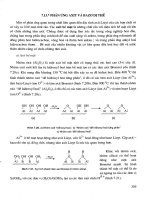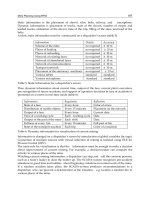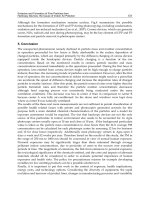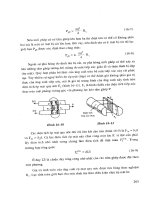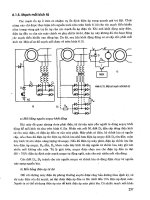Climate Management - Solving the Problem Part 8 potx
Bạn đang xem bản rút gọn của tài liệu. Xem và tải ngay bản đầy đủ của tài liệu tại đây (881.45 KB, 29 trang )
216
CLIMATE MANAGEMENT
winners and Losers
In the United States, the U.S. Global Change Research Program oper-
ates the U.S. National Assessment of the Potential Consequences of
Climate Variability and Change (National Assessment). It breaks the
United States into regional geographic sections (e.g., Pacic Northwest,
Southeast, West, Midwest, Great Plains, Alaska, and so forth), and gen-
erates reports for each region detailing climate impacts and practical
methods of adaptation.
e reports are backed by both scientists and policy makers in the
hope that constructive progress will be made in scientic understanding
and social action. e way the program works, the National Assessment
currently consists of 16 ongoing regional projects. For each of the regional
studies, teams of scientists, resource planners, and other involved par-
ties meet to assess the region’s most critical vulnerabilities in areas such
as agricultural productivity, coastal areas, water resources, forests, and
human health. In addition to looking at potential impacts, the teams also
work together to identify possible strategies that can be used to adapt
and respond to climate change. e overall goal of the project is to help
those in the United States prepare for future climate change.
Future Changes in the Earth’s Environment
under the Eects of Continued Global Warming
(continued)
2100
• Atmospheric CO
2
levels will be higher than they have been for the last
650,000 years (IPCC).
• Ocean pH levels will very likely decrease by as much as 0.5 pH units—
the lowest it has been in the last 20 million years (IPCC).
• Thawing permafrost will make Earth’s land area a new source of
carbon emissions—it will emit more CO
2
into the atmosphere than it
absorbs (IPCC).
• New climate zones will appear on up to 39 percent of Earth’s land
surface (IPCC).
• One-fourth of all plant and land animal species could become extinct
(IPCC).
2 17
The Future: What Lies Ahead
According to Michael MacCracken, who heads the national oce,
“e goal of the assessment is to provide the information for communi-
ties as well as activities to prepare and adapt to the changes in climate
that are starting to emerge.”
A New York Times article of April 2, 2007, outlined which countries
will be hit the hardest as climate change progresses. ere will be what
they refer to as winners and losers. It is known that the industrial-
ized nations are the largest producers of GHGs. In general, it is the
industrialized countries that are also the best equipped to deal with
the eects of global warming and to mitigate by nancing adaptive
measures. Unfortunately, it is the poorer nations that lie closer to the
Tropics—even though they have not contributed to the GHG emission
problem as signicantly—that will be dealt the majority of the worst
side eects, such as drought, crop failure, heat waves, ooding, and
sea-level rise.
e Times article mentioned several geographic areas worldwide
that are already in the process of adapting to climate change. In Shish-
maref, Alaska, for example, on a low-lying island, the town is in the pro-
cess of relocating because the island is already being eroded by changes
in sea level. e estimated costs to relocate are estimated at $180 mil-
lion. e shoreline has receded three to ve feet (0.9–1.5 m) per year
and is especially vulnerable when tidal high water is combined with
intense wave action of the Chukchi Sea during storms. e community
is relocating to an area on the mainland that is accessible to the sea and
will provide the community with the subsistence lifestyle they are used
to, allowing them to hold on to their tribal culture.
e U.S. corn belt is genetically modifying crop varieties that are
designed for drought and pest resistance so that farmers will be able to
sustain their yields in the hotter, drier years to come. London is cur-
rently making improvements to their ood protection infrastructure
on the ames River to guard against ooding events as the climate
warms. On Sylt Island in Germany, a pilot project is underway to build
more resilient dykes out of rocks that are precoated with exible poly-
urethane. is keeps the dike from being weathered by the North Sea
by both absorbing the force of the breaking waves and slowing down
the water masses.
218
Climate management
This map shows the per capita responsibility for GHGs worldwide. In
many cases, the largest offenders are often the most wealthy, indus-
trialized nations that are likely to encounter the least in losses overall
because they have many of the resources necessary to mitigate the
negative effects. Unfortunately, the countries that are likely to en-
counter the greatest losses are the undeveloped countries and those
located close to sea level that have not contributed significantly to
the global warming problem. (Source: World Resources Institute)
In Andermatt, Switzerland, one ski resort has had to construct
a ramp each ski season in order to gain access to a steadily reced-
ing glacier. e ramp has now been covered with a reective cover
to protect it from melting. Venice, Italy, which is extremely prone to
ooding from sea-level rise, is constructing oodgates to protect the
city’s infrastructure during extremely high tides. In Northern China
219
The Future: What Lies Ahead
in a very dry region, a project is under construction to divert water
hundreds of miles from the Yangtze River in the south. In Perth, Aus-
tralia, they have nished construction on a desalination plant to serve
as a backup source of water to oset shrinking natural supplies as a
result of prolonged drought conditions. As global warming continues,
locations will have to continue to adapt to changing conditions as they
arise.
new TeChnoLogies
In an April 2008 Scientic American article, Jerey D. Sachs, head of the
Earth Institute at Columbia University, said that, “Even with a cutback
in wasteful energy spending, our current technologies cannot support
both a decline in carbon dioxide emissions and an expanding global
economy. If we try to restrain emissions without a fundamentally new
set of technologies, we will end up stiing economic growth, including
the development prospects for billions of people.”
What Mr. Sachs says is needed is a huge investment of resources
and eort into new technologies that are low carbon and this will not
happen with the kind of eort toward research that has occurred so far.
It will require the serious, dedicated involvement of determined gov-
ernment leadership and resources; a program so intense and focused,
he refers to it as a “Manhattan-like Project.”
As researchers learn more about global warming and gain a better
understanding of the complex interactions of the climate system, this
knowledge coupled with technology should lead to even better solu-
tions. Over the past 30 years, computing power has increased by a fac-
tor of 1 million. Models today are becoming much more complex and
realistic. As a better understanding is reached of the nature of feedbacks
from the carbon cycle and their constraints on the climate response,
models are becoming much more sophisticated. New “petascale” com-
puter models depicting detailed climate dynamics are now building the
foundation for the next generation of complex climate models. New
advanced computing abilities will help climatologists better understand
the links between weather and climate.
is new technology is being developed by researchers at the Uni-
versity of Miami Rosenstiel School of Marine and Atmospheric Science
220
Climate management
(RSMAS), the National Center for Atmospheric Research (NCAR) in
Boulder, Colorado, the Center for Ocean-Land-Atmospheric Studies
(COLA) in Calverton, Maryland, and the University of California at
Berkeley. ey are using a $1.4 million award from the National Science
Foundation (NSF) to generate the new models.
e scientists at these institutions say that the development of pow-
erful supercomputers capable of analyzing decades of data in the blink
of an eye marks a technological milestone capable of bringing com-
prehensive changes to science. e speed of supercomputing is mea-
sured in how many calculations can be performed in a given second.
Petascale computers can make 1,000,000,000,000,000 calculations per
second, an enormous amount of calculations even when comparing it
to an advanced supercomputer. Because of the “peta’s” capabilities, this
represents a breakthrough and a golden opportunity for climatologists
to advance Earth science system science and help to improve the qual-
ity of life on the planet.
Jay Fein, NSF program director, says, “e limiting factor to more
reliable climate predictions at higher resolution is not scientic ideas,
but the computational capacity to implement those ideas. is project
is an important step forward in providing the most useful scientically
based climate change information to society for adapting to climate
change.”
One thing researchers have learned recently through modeling is
that climate cannot be predicted independently of weather. ey have
discovered that weather has a profound impact on climate. Now that
they have discovered this, they expect to be able to greatly improve
weather and climate predictions and climate change projections. In
addition, with the increase in computing capabilities, one of the team
members—Ben Kirtman, a meteorologist at RSMAS—has developed
a new weather and climate modeling strategy which he calls “interac-
tive ensembles,” which is designed to isolate the interactions between
weather and climate.
e interactive ensembles for weather and climate modeling are
currently being applied to one of the United States’ main climate change
models—NCAR’s Community Climate System Model (CCSM), the cur-
rent operational model used by NOAA’s climate forecast system (CFS).
221
The Future: What Lies Ahead
Continual warming temperatures will eventually affect every person
on the Earth. (Nature’s Images)
e CCSM is also a model used by hundreds of researchers and is also
one of the climate models that was used in the Nobel Prize–winning
IPCC assessments.
e research currently being done serves as a pilot program for
the implementation of even more complicated computational systems,
which, today, still remain a scientic and engineering challenge.
222
Climate management
According to Kirtman, “is marks the rst time that we will have
the computational resources available to address these scientic chal-
lenges in a comprehensive manner. e information from this project
will serve as a cornerstone for petascale computing in our eld and help
to advance the study of the interactions between weather and climate
phenomena on a global scale.” Models will continue to play an impor-
tant role in the future, and, as more of the interactions between the
atmosphere, geosphere, biosphere, and hydrosphere are understood
along with the carbon cycle, greater insight will become available as to
how more eciently to combat global warming.
The FinaL ChoiCe
e dening moment will be when people realize that it is a personal
decision must be made jointly by every individual on Earth. And that
choice will be as individual as the person himself. It will be a compila-
tion of personal values, beliefs, character, and goals for the future. And
each individual’s choice will count; each will have equal weight in this
war against time.
In the end, each person will have to study the issues and make up
their own mind. Each person will have to assess how their actions may
aect the lives of their children, grandchildren, and future generations.
A plant takes from the soil only what it needs.
In the same way, we too should only take from the
Earth what we need to ourish.
—Chiara Lubich to young people
e solution to global warming is tied to each individual on this Earth.
Ultimately, the solution boils down to one question: “How much are
you willing to sacrice to do your part?”
223
unFCCC member naTions
aPPendIx a
Afghanistan
Albania
Algeria
Angola
Antigua and Barbuda
Argentina
Armenia
Australia
Austria
Azerbaijan
Bahamas
Bahrain
Bangladesh
Barbados
Belarus
Belgium
Belize
Benin
Bhutan
Bolivia
Bosnia and Herzegovina
Botswana
Brazil
Brunei
Bulgaria
Burkina Faso
Burundi
Cambodia
Cameroon
Canada
Cape Verde
Central African Republic
Chad
Chile
China
Colombia
Comoros
Congo, Democratic Republic of
the
Congo, Republic of the
Cook Islands
Costa Rica
Côte d’Ivoire
Croatia
Cuba
Cyprus
Czech Republic
Denmark
Djibouti
Dominica
Dominican Republic
Ecuador
Egypt
El Salvador
Equatorial Guinea
Eritrea
Estonia
Ethiopia
224
Climate management
European Union
Fiji
Finland
France
Gabon
Gambia
Georgia
Germany
Ghana
Greece
Grenada
Guatemala
Guinea
Guinea-Bissau
Guyana
Haiti
Honduras
Hungary
Iceland
India
Indonesia
Iran
Ireland
Israel
Italy
Jamaica
Japan
Jordan
Kazakhstan
Kenya
Kiribati
Korea, North
Korea, South
Kuwait
Kyrgyzstan
Laos
Latvia
Lebanon
Lesotho
Liberia
Libya
Liechtenstein
Lithuania
Luxembourg
Macedonia, Republic of
Madagascar
Malawi
Malaysia
Maldives
Mali
Malta
Marshall Islands
Mauritania
Mauritius
Mexico
Micronesia, Federated States of
Moldova
Monaco
Mongolia
Montenegro
Morocco
Mozambique
Myanmar
Namibia
Nauru
Nepal
Netherlands
New Zealand
Nicaragua
Niger
Nigeria
Niue
225
appendix a
Norway
Oman
Pakistan
Palau
Panama
Papua New Guinea
Paraguay
Peru
Philippines
Poland
Portugal
Qatar
Romania
Russia
Rwanda
Saint Kitts and Nevis
Saint Lucia
Saint Vincent and the Grenadines
Samoa
San Marino
Sao Tome and Principe
Saudi Arabia
Senegal
Serbia
Seychelles
Sierra Leone
Singapore
Slovakia
Slovenia
Solomon Islands
South Africa
Spain
Sri Lanka
Sudan
Suriname
Swaziland
Sweden
Switzerland
Syria
Tajikistan
Tanzania
ailand
Timor-Leste
Togo
Tonga
Trinidad and Tobago
Tunisia
Turkey
Turkmenistan
Tuvalu
Uganda
Ukraine
United Arab Emirates
United Kingdom
United States
Uruguay
Uzbekistan
Vanuatu
Venezuela
Vietnam
Yemen
Zambia
Zimbabwe
226
how To Take aCTion now
e following is a list of several notable organizations and personnel
that provide research, information, and ways to get personally involved
in ghting global warming. e Web sites were all accessed for avail-
ability as of May 15, 2009.
aL gore
With the humor and humanity exuded in An Inconvenient Truth, Al
Gore spells out 15 ways that individuals can address climate change
immediately, from buying a hybrid to inventing a new, hotter “brand
name” for global warming. URL: />lang/eng/al_gore_on_averting_climate_crisis.html.
beyond kyoTo
An essay that argues for small steps to reduce carbon dioxide emissions
today that can make a big dierence down the road. URL: http://www.
foreignaairs.com/articles/59916/john-browne/beyond-kyoto.
Carbon CaLCuLaTor For your Carbon use
Everyone contributes to global warming every day. e CO
2
everyone
produces by driving the car and leaving the lights on adds up quickly.
It is surprising how much CO
2
each person emits each year. Calculate
your personal impact and learn how to take action to reduce or even
eliminate individual emissions of CO
2
. URL: matecrisis.
net/takeaction/carboncalculator/.
CenTer For bioLogiCaL diversiTy
e center believes that the welfare of human beings is deeply linked to
nature—to the existence in the world of a vast diversity of wild animals
and plants. Because diversity has intrinsic value and because its loss
impoverishes society, they work to secure a future for all species, great
aPPendIx B
227
appendix B
and small, hovering on the brink of extinction. ey do so through
science, law, and creative media, with a focus on protecting the lands,
waters, and climate that each species needs to survive. URL: http://www.
biologicaldiversity.org/index.html.
CiTies For CLimaTe ProTeCTion
e International Council for Local Environmental Initiatives enlists
cities to adopt policies and implement measures to achieve quantiable
reductions in local GHGs, improve air quality, and enhance the urban
quality of life. URL: />CLean air CooL PLaneT’s CamPus CLimaTe aCTion
TooLkiT For CoLLeges and universiTies
Oers helpful information on the steps that can be taken to make edu-
cational institutions more climate friendly. e site includes guidance
for every aspect of campus climate action along with hyperlinks to tech-
nical resources and examples/case studies that will help people under-
stand, plan, and execute or implement a climate action plan’s various
elements. URL: www.cleanair-coolplanet.org/toolkit/.
CLimaTe aCTion regisTry rePorT on-Line TooL
(CarroT)
Helping companies monitor emission reduction goals. It features an online
GHG reporting and calculation tool. URL: .
CLimaTe CamP 2009
A coalition of individuals and groups that weaves four key themes—
education, direct action, sustainable living, and building a movement—
to tackle climate change both resisting climate crimes and developing
sustainable solutions. URL: />CLimaTe hoT maP
An interactive map based on IPCC report data illustrating the most vul-
nerable areas worldwide under the inuence and progression of global
warming. URL: />228
Climate management
ConvergenCe For CLimaTe aCTion—
summer 2008
U.S. member of international grassroots movement that plans to work
with and support communities on the front lines of the climate struggle
and take direct action against the fossil fuel empire. URL: http://www.
climateconvergence.org/.
earTh insTiTuTe
e Earth Institute’s goal is to help achieve sustainable development
primarily by expanding the world’s understanding of Earth as one inte-
grated system. ey work toward this goal through scientic research,
education, and the practical application of research for solving real-
world challenges. With 850 scientists, postdoctoral fellows, and stu-
dents working in and across more than 20 Columbia University research
centers, the Earth Institute is helping to advance nine interconnected
global issues: climate and society, water, energy, poverty, ecosystems,
public health, food and nutrition, and hazards and urbanization. URL:
/>earThjusTiCe
EarthJustice is a nonprot public interest law rm dedicated to protect-
ing the magnicent places, natural resources, and wildlife of this Earth
and to defending the rights of all people to a healthy environment. ey
bring about far-reaching change by enforcing and strengthening envi-
ronmental laws on behalf of hundreds of organizations, coalitions, and
communities. URL: />environmenTaL deFense Fund
e Environmental Defense is a not-for-prot environmental advo-
cacy group with four main goals: (1) stabilizing the Earth’s climate, (2)
safeguarding the world’s oceans, (3) protecting human health, and (4)
defending and restoring biodiversity. ey start with rigorous science,
and then work directly with businesses, government, and communities.
Together, they create lasting solutions to the most serious environmental
problems. One of their top priorities is to pass national legislation that
caps global warming pollution and creates a exible emissions trading
229
appendix B
market so that it will open the door to a “green technology revolution.”
URL: />gLobaL green
Founded in 1993 by activist and philanthropist Diane Meyer Simon,
Global Green is the American Arm of Green Cross International
(GCI), which was created by President Mikhail S. Gorbachev to foster
a global value shi toward a sustainable and secure future by recon-
necting humanity with the environment. Global Green is working
to address some of the greatest challenges facing humanity. In the
United States their work is primarily focused on stemming global
climate change by creating green buildings and cities. URL: http://
globalgreen.org/.
greenPeaCe
eir core values are reected in their environmental campaign work:
“We ‘bear witness’ to environmental destruction in a peaceful, nonvi-
olent manner. We use nonviolent confrontation to raise the level and
quality of public debate. In exposing threats to the environment and
nding solutions we have no permanent allies or adversaries. We ensure
our nancial independence from political or commercial interests. We
seek solutions for, and promote open, informed debate about society’s
environmental choices.” URL: />inTernaTionaL CounCiL on LoCaL
environmenTaL iniTiaTives (iCLei)
Technical support and toolkits for participants in the Cities for Climate
Protection campaign. URL: www.iclei.org.
NATIoNAl GeoGrAPhIC
Since 1888, they have traveled the Earth, sharing its amazing stories
with each new generation. National Geographic’s mission programs
support critical expeditions and scientic eldwork, encourage geo-
graphic education for students, promote natural and cultural conser-
vation, and inspire audiences through new media, vibrant exhibitions,
and live events. URL: .
230
Climate management
naTuraL resourCes deFense CounCiL
NRDC uses law, science, and the support of more than 500,000 mem-
bers nationwide to protect the planet’s wildlife and wild places and to
ensure a safe and healthy environment for all living things. NRDC’s
“Turn Up the Heat: Fight Global Warming” campaign empowers people
concerned about global warming to turn up the heat on politicians and
business leaders to act now to put solutions to global warming in place.
NRDC is the nation’s most eective environmental action group, com-
bining the grassroots power of 1.2 million members and online activ-
ists with the courtroom clout and expertise of more than 350 lawyers,
scientists and other professionals. URL: />norThwesT earTh insTiTuTe
e Northwest Earth Institute is recognized as a national leader in the
development of innovative programs that empower individuals and
organizations to transform culture toward a sustainable and enrich-
ing future. ey oer an educational course on global warming. URL:
/>Pew CLimaTe grouP
Business leadership group that oers strategies to ght global warming.
Oers lots of educational resources. URL: www.pewclimate.org.
sierra CLub
“Protecting the environment . . . for our families, for our future.” e
Sierra Club has been devoted to preserving nature’s miracles for over
100 years. is map builds on work undertaken by the Sierra Club,
which published a report on global warming and extreme weather in
the United States in August 1998. URL: />union oF ConCerned sCienTisTs
UCS is an independent nonprot alliance of 50,000 concerned citizens
and scientists across the country. ey augment rigorous scientic
analysis with innovative thinking and committed citizen advocacy to
build a cleaner, healthier environment and a safer world. URL: http://
www.ucsusa.org/.
231
appendix B
usa’s environmenTaL ProTeCTion agenCy’s
sTaTe aCTion PLans
is Web site oers information on current climatic changes; emissions
and concentrations of greenhouse gases; local climate changes; future
climate changes; eects on human health; and the status of climate
change impact to water resources, agriculture, forests, and ecosystems
for each individual state in the United States. URL: .
gov/oar/globalwarming.nsf/content/ImpactsStateImpacts.html.
u.s. Congress
A resource to nd out who are your state senators and representatives
in Washington, D.C. URL: />html.
u.s. green buiLding CounCiL’s LeadershiP in
energy and environmenTaL design (Leed)
is Web site oers criteria for ecient building construction and ren-
ovation, being adopted widely by the U.S. military and others. URL:
www.usgbc.org.
u.s. PubLiC inTeresT researCh grouP
e state PIRGs created the U.S. Public Interest Research Group (U.S.
PIRG) in 1983 to act as watchdog for the public interest in the nation’s
capital, as much as PIRGs have worked to safeguard the public interest
in state capitals since 1971. URL: />wiLderness soCieTy
e society’s chief goal is to protect America’s wilderness, not as a relic of
the nation’s past, but as a thriving ecological community that is central
to life itself. To meet their goals, they use science and collaboration with
communities and conservation groups to bring about sensible policies
and positive change in land conservation. URL: />worLd resourCes insTiTuTe
WRI provides information, ideas, and solutions to global environmen-
tal problems. eir mission is to move human society to live in ways
232
Climate management
that protect Earth’s environment for current and future generations.
eir program meets global challenges by using knowledge to catalyze
public and private action. URL: />worLd wiLdLiFe Fund
World Wildlife Fund (WWF) is dedicated to protecting the world’s wild-
life and wild lands. WWF directs its conservation eorts toward three
global goals: protecting endangered spaces, saving endangered species,
and addressing global threats. URL: />233
Chronology
ca. 1400–1850 Little Ice Age covers the Earth with record cold, large
glaciers, and snow. There is widespread disease, starvation,
and death.
1800–70 The levels of CO
2
in the atmosphere are 290 ppm.
1824 Jean-Baptiste Joseph Fourier, a French mathematician and
physicist, calculates that the Earth would be much colder
without its protective atmosphere.
1827 Jean-Baptiste Joseph Fourier presents his theory about the
Earth’s warming. At this time many believe warming is a
positive thing.
1859 John Tyndall, an Irish physicist, discovers that some gases
exist in the atmosphere that block infrared radiation. He
presents the concept that changes in the concentration of
atmospheric gases could cause the climate to change.
1894 Beginning of the industrial pollution of the environment.
1913–14 Svante Arrhenius discovers the greenhouse effect and
predicts that the Earth’s atmosphere will continue to warm.
He predicts that the atmosphere will not reach dangerous
levels for thousands of years, so his theory is not received
with any urgency.
1920–25 Texas and the Persian Gulf bring productive oil wells into
operation, which begins the world’s dependency on a
relatively inexpensive form of energy.
1934 The worst dust storm of the dust bowl occurs in the United
States on what historians would later call Black Sunday. Dust
storms are a product of drought and soil erosion.
1945 The U.S. Office of Naval Research begins supporting many
fields of science, including those that deal with climate
change issues.
234
Climate management
1949–50
Guy S. Callendar, a British steam engineer and inventor,
propounds the theory that the greenhouse effect is linked to
human actions and will cause problems. No one takes him
too seriously, but scientists do begin to develop new ways to
measure climate.
1950–70 Technological developments enable increased awareness about
global warming and the enhanced greenhouse effect. Studies
confirm a steadily rising CO
2
level. The public begins to notice
and becomes concerned with air pollution issues.
1958 U.S. scientist Charles David Keeling of the Scripps Institution
of Oceanography detects a yearly rise in atmospheric CO
2
. He
begins collecting continuous CO
2
readings at an observatory
on Mauna Loa, Hawaii. The results became known as the
famous Keeling Curve.
1963 Studies show that water vapor plays a significant part in
making the climate sensitive to changes in CO
2
levels.
1968 Studies reveal the potential collapse of the Antarctic ice sheet,
which would raise sea levels to dangerous heights, causing
damage to places worldwide.
1972 Studies with ice cores reveal large climate shifts in the past.
1974 Significant drought and other unusual weather phenomenon
over the past two years cause increased concern about climate
change not only among scientists but with the public as a
whole.
1976 Deforestation and other impacts on the ecosystem start to
receive attention as major issues in the future of the world’s
climate.
1977 The scientific community begins focusing on global warming
as a serious threat needing to be addressed within the next
century.
1979 The World Climate Research Programme is launched to
coordinate international research on global warming and
climate change.
235
Chronology
1982
Greenland ice cores show significant temperature oscillations
over the past century.
1983 The greenhouse effect and related issues get pushed into
the political arena through reports from the U.S. National
Academy of Sciences and the Environmental Protection
Agency.
1984–90 The media begins to make global warming and its enhanced
greenhouse effect a common topic among Americans. Many
critics emerge.
1987 An ice core from Antarctica analyzed by French and Russian
scientists reveals an extremely close correlation between CO
2
and temperature going back more than 100,000 years.
1988 The United Nations set up a scientific authority to review
the evidence on global warming. It is called the Inter-
governmental Panel on Climate Change (IPCC) and consists of
2,500 scientists from countries around the world.
1989 The first IPCC report says that levels of human-made
greenhouse gases are steadily increasing in the atmosphere and
predicts that they will cause global warming.
1990 An appeal signed by 49 Nobel prizewinners and 700 members
of the National Academy of Sciences states, “There is broad
agreement within the scientific community that amplification
of the Earth’s natural greenhouse effect by the buildup of
various gases introduced by human activity has the potential to
produce dramatic changes in climate . . . Only by taking action
now can we insure that future generations will not be put at
r i s k .”
1992 The United Nations Conference on Environment and
Development (UNCED), known informally as the Earth
Summit, begins on June 3 in Rio de Janeiro, Brazil. It results
in the United Nations Framework Convention on Climate
Change, Agenda 21, the Rio Declaration on Environment and
Development Statement of Forest Principles, and the United
Nations Convention on Biological Diversity.
236
Climate management
1993
Greenland ice cores suggest that significant climate change can
occur within one decade.
1995 The second IPCC report is issued and concludes there is a
human-caused component to the greenhouse effect warming.
The consensus is that serious warming is likely in the coming
century. Reports on the breaking up of Antarctic ice sheets and
other signs of warming in the polar regions are now beginning
to catch the public’s attention.
1997 The third conference of the parties to the Framework
Convention on Climate Change is held in Kyoto, Japan.
Adopted on December 11, a document called the Kyoto
Protocol commits its signatories to reduce emissions of
greenhouse gases.
2000 Climatologists label the 1990s the hottest decade on record.
2001 The IPPC’s third report states that the evidence for
anthropogenic global warming is incontrovertible, but that
its effects on climate are still difficult to pin down. President
Bush declares scientific uncertainty too great to justify Kyoto
Protocol’s targets.
The United States Global Change Research Program releases
the findings of the National Assessment of the Potential
Consequences of Climate Variability and Change. The
assessment finds that temperatures in the United States will
rise by 5 to 9°F (3–5°C) over the next century and predicts
increases in both very wet (flooding) and very dry (drought)
conditions. Many ecosystems are vulnerable to climate change.
Water supply for human consumption and irrigation is at risk
due to increased probability of drought, reduced snow pack,
and increased risk of flooding. Sea-level rise and storm surges
will most likely damage coastal infrastructure.
2002 Second hottest year on record.
Heavy rains cause disastrous flooding in Central Europe leading
to more than 100 deaths and more than $30 billion in damage.
Extreme drought in many parts of the world (Africa, India,
237
Chronology
Australia, and the United States) results in thousands of deaths
and significant crop damage. President Bush calls for 10 more
years of research on climate change to clear up remaining
uncertainties and proposes only voluntary measures to mitigate
climate change until 2012.
2003 U.S. senators John McCain and Joseph Lieberman introduce a
bipartisan bill to reduce emissions of greenhouse gases nation-
wide via a greenhouse gas emission cap and trade program.
Scientific observations raise concern that the collapse of ice
sheets in Antarctica and Greenland can raise sea levels faster
than previously thought.
A deadly summer heat wave in Europe convinces many in Europe
of the urgency of controlling global warming but does not equally
capture the attention of those living in the United States.
International Energy Agency (IEA) identifies China as
the world’s second largest carbon emitter because of their
increased use of fossil fuels.
The level of CO
2
in the atmosphere reaches 382 ppm.
2004 Books and movies feature global warming.
2005 Kyoto Protocol takes effect on February 16. In addition, global
warming is a topic at the G8 summit in Gleneagles, Scotland,
where country leaders in attendance recognize climate change
as a serious, long-term challenge.
Hurricane Katrina forces the U.S. public to face the issue of
global warming.
2006 Former U.S. vice president Al Gore’s An Inconvenient Truth
draws attention to global warming in the United States.
Sir Nicholas Stern, former World Bank economist, reports that
global warming will cost up to 20 percent of worldwide gross
domestic product if nothing is done about it now.
2007 IPCC’s fourth assessment report says glacial shrinkage, ice
loss, and permafrost retreat are all signs that climate change is
238
Climate management
underway now. They predict a higher risk of drought, floods,
and more powerful storms during the next 100 years.
Al Gore and the IPCC share the Nobel Peace Prize for their
efforts to bring the critical issues of global warming to the
world’s attention.
2008 The price of oil reached and surpassed $100 per barrel, leaving
some countries paying more than $10 per gallon.
Energy Star appliance sales have nearly doubled. Energy Star
is a U.S. government-backed program helping businesses and
individuals protect the environment through superior energy
efficiency.
U.S. wind energy capacity reaches 10,000 megawatts, which is
enough to power 2.5 million homes.
2009 President Obama takes office and vows to address the issue
of global warming and climate change by allowing individual
states to move forward in controlling greenhouse gas
emissions. As a result, American automakers can prepare for
the future and build cars of tomorrow and reduce the country’s
dependence on foreign oil. Perhaps these measures will help
restore national security and the health of the planet, and the
U.S. government will no longer ignore the scientific facts.
The year 2009 will be a crucial year in the effort to
address climate change. The meeting on December 7–18
in Copenhagen, Denmark, of the UN Climate Change
Conference promises to shape an effective response to climate
change. The snapping of an ice bridge in April 2009 linking
the Wilkins Ice Shelf (the size of Jamaica) to Antarctic islands
could cause the ice shelf to break away, the latest indication
that there is no time to lose in addressing global warming.
The EPA took a major step on December 7, 2009, by declaring
carbon dioxide a dangerous pollutant, allowing the Obama
administration to regulate the tailpipe and smokestack
emissions that add to global warming.
239
glossary
adaptation an adjustment in natural or human systems to a new
or changing environment. Adaptation to climate change refers to
adjustment in natural or human systems in response to actual or
expected climatic changes.
aerosols tiny bits of liquid or solid matter suspended in air. They
come from natural sources such as erupting volcanoes and from
waste gases emitted from automobiles, factories, and power plants.
By reflecting sunlight, aerosols cool the climate and offset some of
the warming caused by greenhouse gases.
albedo the relative reflectivity of a surface. A surface with high
albedo reflects most of the light that shines on it and absorbs very
little energy; a surface with a low albedo absorbs most of the light
energy that shines on it and reflects very little.
anthropogenic emissions made by people or resulting from human
activities. This term is usually used in the context of emissions that
are produced as a result of human activities.
atmosphere the thin layer of gases that surround the Earth and allow
living organisms to breathe. It reaches 400 miles (644 km) above
the surface, but 80 percent is concentrated in the troposphere—the
lower 7 miles (11 km) above the Earth’s surface.
biodiversity different plant and animal species.
biofuel a fuel produced from organic matter or combustible oils
produced by plants. Examples of biofuel include alcohol, black
liquor from the paper-manufacturing process, wood, and soybean
oil.
biomass the total mass of living organisms in a given area or volume;
dead plant material can be included as dead biomass.
black carbon soot or charcoal and/or possible light-absorbing refrac-
tory organic matter.
240
Climate management
bleaching (coral) the loss of algae from corals that causes the corals to
turn white. This is one of the results of global warming and signifies
a die-off of unhealthy coral.
cap and trade the cap and trade system involves the trading of emission
allowances, where the total allowance is strictly limited or capped.
Emissions trading is an administrative approach used to control pollu-
tion by providing economic incentives for achieving reductions in the
emissions of pollutants. A company is allowed to have a specified level
of pollution that they can sell and trade. If a company exceeds their
limit, they can buy credits to decrease global warming elsewhere.
carbon a naturally abundant nonmetallic element that occurs in
many inorganic and in all organic compounds.
carbon capture and storage (CCS) a process consisting of separation of
CO
2
from industrial and energy-related sources, transport to a stor-
age location, and long-term isolation from the atmosphere.
carbon cycle the term used to describe the flow of carbon (in various
forms, such as carbon dioxide) through the atmosphere, ocean, ter-
restrial biosphere, and lithosphere.
carbon dioxide a colorless, odorless gas that passes out of the lungs
during respiration. It is the primary greenhouse gas and causes the
greatest amount of global warming.
carbon sink an area where large quantities of carbon are built up in
the wood of trees, in calcium carbonate rocks, in animal species, in
the ocean, or any other place where carbon is stored. These places
act as a reservoir, keeping carbon out of the atmosphere.
chaos theory a theory to explain the nonlinear, deterministic behav-
ior of certain systems. A dynamical system such as the climate sys-
tem, governed by nonlinear deterministic equations, may exhibit
erratic or chaotic behavior in that very small changes in the initial
state of the system in time lead to large and apparently unpredict-
able changes in its temporal evolution. Chaotic behavior may limit a
model’s predictability.
climate the usual pattern of weather that is averaged over a long
period of time.

